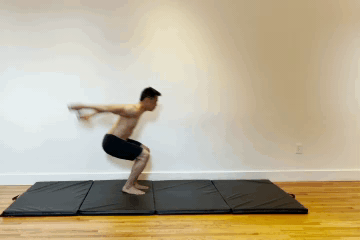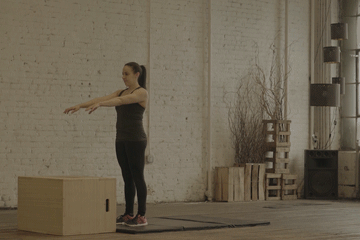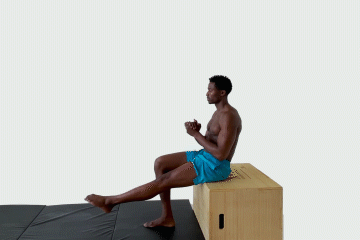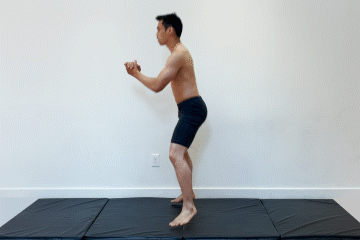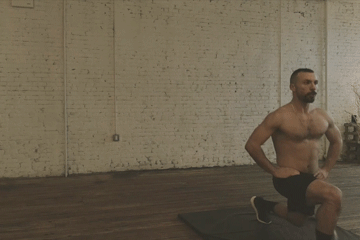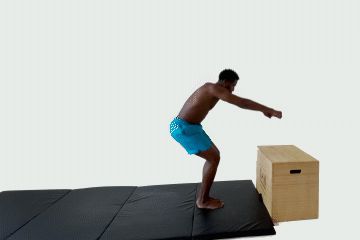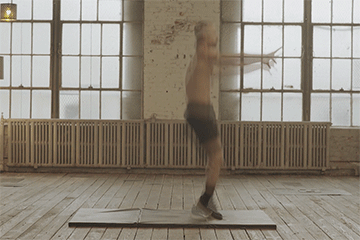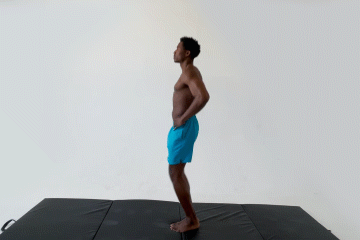Adding explosive power to your steps will help you become faster and more agile on the field or court. Not only that, but explosive leg exercises are also great for preventing injuries and building muscle. In this article, we will discuss 17 explosive calisthenics leg exercises that you can do at home with just your body weight!
🎯Summary:
We’ll cover the following subject in this article:
- 🔎What is explosiveness
- 🔎Why is it important to train
- 🔎17 Explosive calisthenics leg exercises
- 🔎Explosive calisthenics workout sample
- 🔎Plyometrics vs explosive training
- 🔎& Frequently Asked Questions
If you’re looking into more leg exercises, then check out this article: 101 Bodyweight Leg Exercises: The Ultimate List
Let’s start!
What is explosiveness?🤔
Explosiveness is the ability to generate maximum power in a short amount of time. It’s important to train explosiveness because it helps improve your speed, agility, and explosive strength. You can train explosiveness by doing plyometric exercises like jump squats, box jumps, and sprints.
For this article, we’re going to specifically cover building explosiveness for the lower body. However, you can also build explosiveness for your upper body to develop power for punching, throwing, and other similar motions.
✊Why is it important to train?
There are times, especially when participating in high-impact sports, is necessary for optimized and safe movement.
Here are the following reasons why you should develop power and not only work on your strength:
- ✅Enables you to run faster
- ✅Increase vertical jump
- ✅Helps you jump further
- ✅Improves reaction time
- ✅Prevents and reduces injuries
- ✅Increases overall power
- ✅Trains your speed, quickness, and agility
- ✅Strengthens your kicks
- ✅Better body connection and control at maximum force production
✨Basics for explosive training
When we’re talking about strength, we’re focusing on power. In our context of defining power, we can translate it into an equation:
POWER = FORCE x VELOCITY
The higher your strength capacity is, the more force you can produce to increase your power. Velocity is speed. The faster you can produce that force, the more power you can generate.
Now, let’s get a bit deeper into how can you produce more power which we can cover by analyzing the two components for generating power.
⚡️Active muscular component
This component refers to your strength or the amount of force your body can produce. So training your strength through your calisthenics basics is the best way to improve this.
You don’t have to go fast with your movement patterns. Train the regular squats and lunges with a good slow tempo and good form. The stronger you get, the better foundation you set for your strength levels.
With this component, you need to train with high loads so you naturally will move slower since you will not be able to produce fast movements with heavy loads.
Another optimal way to develop strength is through weighted squats. Yes, it’s not calisthenics but that’s the main advantage of lifting weights. With weights, you’re not limited with your body weight so you can train for your absolute strength.
Before training for explosiveness, always master your fundamental movements first!
⚡️Neuromuscular component
Training for this component teaches your brain to move your body at will at the fastest it can go. It develops the muscular coordination of your nerves and the neuro pathways. This way, you can contract your muscles at a faster rate. As a result, it trains the velocity component in our power equation mentioned above.
☝️Caution!
Explosive training is very taxing and stresses the joints. As seen in the power equation, strength plays a huge factor in producing power. Hence, if you have limited strength and capacity to handle fast movement, injuries can occur.
Setting a strong foundation with proper strength training such as mastering at least the basic bodyweight squat with full control, correct form and slow movement is VITAL.
You should also check with your healthcare specialist personally to identify any weaknesses that can hinder you from training for power.
Don’t rush the process and first master the basics.☝️
🔥17 Explosive Calisthenics Leg Exercises
🤜Jump squats – Scalable
Jump squats are one of the most basic yet highly effective exercises to promote more power. It’s very simple and can yield results. Beginners to advanced can also take advantage of this exercise. Aside from building power, this exercise translates to higher jumps as well.
These are performed by starting at the bottom of the squat and then exploding upward into a jump. You can perform this exercise by swinging your arms to develop coordination for a higher jump or relying solely on your legs to develop power. After the jump, catch yourself then go straight to the bottom of the squat then follow up with the next repetition.
Before using this exercise, be sure that you already have mastered the regular squat to avoid injuries and maximize results.
🤜Tuck jump squats – Scalable
Tuck jumps are quite similar to the jump squats but with an added tuck at the top position of your jump. This means that you should have enough height to tuck your knees towards your chest and be mobile enough to do the movement.
Tuck jumps are scalable, but you can say it’s more on the intermediate level because of the higher jump requirement and mobility component needed for the exercise.
This exercise translates well for movements such as jumping over obstacles or parkour.
🤜Jumping lunges – Scalable
Jumping lunges is another scalable exercise that could also fall into the intermediate category. This is because you should be strong enough to perform regular lunges which is a unilateral exercise. This means that one leg is working harder in each jump.
Jumping lunges puts emphasis on the glutes and hamstrings, but there is also a quadriceps stimulation especially if you open up a wider split.
Balance and coordination are better trained in this exercise because of the unilateral movement. Core strength is also required for stabilization.
🤜Jumping pistol squat – Advanced
This exercise is reserved for the more advanced athletes. You need to be able to perform a pistol squat easily if you want to perform this exercise. Jumping pistol squat is a high-level unilateral explosive exercise that develops power for each leg separately making it perfect for fixing imbalances (or creating if you’re not following proper training protocols to 📍correct muscle imbalances).
Work on your📍 pistol squat progressions before attempting this move.
🤜Long jump – Scalable
You can also work on your jumps in a horizontal manner rather than just going vertical. Horizontal jumps are perfect for creating more power that translates to this specific movement pattern of jumping further. You can easily jump over a puddle no matter how big after working on this exercise.
🤜High jump- Advanced
High jumps are maxed effort jumps by producing maximum force using your lower body and taking advantage of the upper body to propel yourself to maximum height. This is done through a rapid arm swing upward as you jump and downward swing during the descent.
This means that in this exercise, all of your upper body push and pull workouts will translate to a higher jump.
🤜Box jump – Scalable
If you’re looking into improving your explosiveness, then box jumps are the way to go. This exercise forces you to produce enough force to reach the elevated surface as well as get enough mobility and control to stick the landing.
Of course, there’s a risk involved in this exercise so it’s best to master your foundational calisthenics movements and progress gradually with the exercise.
This exercise is a non-countermovement jump meaning that you will start basically at a “dead” start for every rep compared to depth jumps (we’ll talk more about that later”) wherein you rely on a stretch reflex to get a stronger jump.
🤜Depth Jump – Scalable
One of the most popular and effective ways to get a higher jump and explosive power is the depth jump. This exercise is done by jumping from a height down to the ground and then immediately jumping higher again by maximizing the stretch shortening cycle. This countermovement allows you to get a “spring-like” effect by storing elastic energy, improving muscle-tendon interaction, and allowing you to press down on the ground harder to jump higher.
🤜Single-leg box jump- Advanced
If you’re looking into a bigger challenge, then this exercise can get you occupied for quite some time. The single-leg box jump requires control and much strength for each leg in isolation. It’s like performing a pistol squat and then jumping out of it with force.
🤜Kneel to squat jump – Intermediate
This exercise isolates the glutes to help you develop these muscles for more explosive power. The kneel to squat jump removes the lower leg from the equation so you need to fully rely on your glutes and arm swing to be able to get you in the lower squat position. This isn’t for beginners and you should already have a good glute strength and power before performing this exercise.
🤜Seated explosive pistol squats – Beginner
Can’t do pistol squats yet? Don’t worry. You can still use the pistol squats explosively, but with assistance. The seated explosive pistol squats allow you to isolate each leg and require less balance component from the pistol squat.
🤜Plyo lunge complex – Intermediate
This complex movement pattern allows helps develop control and coordination with multiple motions in the exercise. While improving the coordination, you also get to improve your explosiveness as you need to jump forcefully to transition to the next position. It’s a fun exercise to perform once you have mastered the squat and lunge.
🤜Lunge pulse – Beginner
Lunge pulses are another way to isolate your glutes to develop strength for your explosiveness. You don’t have to jump in this exercise but moving with speed allows you to train the velocity factor for a stronger generation of power.
🤜Candlestick to box jump – Intermediate
The candlestick to box jump exercise takes advantage of the momentum from the roll of the candle stick to the squat. The momentum allows you to generate more force and teaches you how to take advantage of the momentum to get a higher jump. This exercise transfers well to gymnastic tumbles and tricking.
🤜Candlestick to tuck jump – Intermediate
Another variation of the candle stick is to jump into a tuck position in mid-air. If you don’t have an elevated surface or want to minimize the risk of injury, the tuck jump is a good alternative to the box jump.
🤜Explosive calf raises
There’s a lot of power generated by your calves as well rather than just relying on your major leg muscles. Explosive calf raises isolate your calves to help you develop power solely from your calves. A lot of power is translated to your calves so developing this area in isolation promotes excellent power in general.
To perform the exercise, you don’t necessarily have to jump. You might perform a small jumping motion through your calves, but it’s still different compared to the exercise below.
🤜Jumping calf raises
In this exercise, you will have to jump the highest you can solely from the calf raise. Compared to the explosive calf raise, this is more high-intensity and high-impact since you have to generate more force to get your body off the floor with your calves. Ankle preparation is a must to perform this movement safely. Understanding how to land safely and use the rebound effect is also efficient when performing the exercise.
⭐️The Best Explosive Leg Exercise: Box Jumps
👉Box jump progressions
One of our favorite exercises among the 17 on our list is the box jump. It forces you to stay explosive to jump over the obstacle and helps you develop that power you needed.
There are progressions to this exercise to keep you moving forward in your quest for power safely. Through📍 progressive calisthenics and by breaking down the movement into different elements, we get to improve our box jumps efficiently.
Here’s The Movement Athlete’s progression for optimal progress.
👊Strength work
Developing explosive strength starts from the bottom (bad pun intended!). In this specific exercise, starting on a very low surface allows you to stay safe while you’re still improving your power. As you develop more power, you higher we will progress into the exercise. Additional movement makes the progression more complex for better gains.
Stair jump
Low Box Jump
Medium Box Jump
High Box Jump
Burpee Box Jump
Candlestick to Box Jump
🤸Skill work
While it seems jumping is straightforward, there is still skill involved in the movement. This is especially true in the landing phase of the exercise. Learning how to catch the momentum is crucial for a safe landing and learning how to use it immediately for the succeeding rep. Another one is how to use the hips to produce power rather than just using the legs.
Jump Stick
Jump and stick off of the stair
Tuck to bridge (hip explode)
💪Muscle work
Since the box jump requires strength, it will also require a higher potential for strength. This is why muscle work is needed for the skill. The bigger the muscles you have on your legs, the better the potential for the jump.
Full squats
Bulgarian split squats
Single leg box step up
🏃Endurance work
Your muscles should have the capacity to work for extended periods. Although explosive training is relatively short, you still need to get a few reps per set with high quality each rep. That’s why you need to work on the primary muscles for the jump which is the glutes and hamstrings.
Glute ham raises
Hamstring curls
👉Explosive workout
Jump squat – 3 sets of 10 reps
2 minutes rest
Plyo squat complex – 3 sets of 10 reps
90 secs rest
Jumping lunges – 3 sets of 12 reps
90 secs rest
Single-leg explosive leg pogo – 3 sets of 15 reps
60 secs rest
More calisthenics leg workouts for different goals in this article: 📍Complete Guide to Calisthenics Leg Workouts
🧐Frequently Asked Questions:
🔎How can I make explosive movements without jumping?
You can definitely not jump while still training explosiveness. An example is performing lunge pulses which don’t propel you up into the air but still train your explosiveness if given the right effort. Another way is to use moderately heavy weight in squats for example. Go down slowly then as you reach the bottom range, explosively pump into your standing position. This still develops explosiveness.
🔎What is the difference between strength and power?
Being strong and being explosive (having the ability to produce power) are not the same thing.
Strength pertains to the amount of force you can produce. In our context, the amount of force your legs can produce regardless of speed.
Power demands speed. Think of it as producing force at a faster rate. As mentioned earlier, power requires strength.
🔎Do explosive workouts help with endurance?
Explosive workouts are high bursts of energy in a very short amount of time. This means that your body isn’t going to sustain this form of energy expenditure for extended periods.
📍Endurance work is exercises that involve low to moderate intensities for longer lengths. Think of jogging, swimming, or walking. This can be done continuously for 10 minutes or more to help build a longer working capacity which explosive training cannot do.
If you want to build explosiveness, then use the exercises above and workout as an example.
If you want to build endurance, then opt for movements that you can sustain for longer periods of time.
More help on what is cardio here: 📍Is Calisthenics Better Than Endurance?
🔎What is the difference between plyometric exercises and explosive training?
This can get quite confusing. Usually, people use to interchange the two terms. Both require power, but there are slight technical differences that actually make a difference in development.
The major difference lies in the amount of time that your feet are in contact with the ground.
🔎Plyometric workouts
Plyometric exercises are explosive movements that use the fast stretch-shortening cycle to produce force. The SSC is a muscle contraction that occurs when a muscle lengthens and then shortens rapidly in a very short amount of time. An example of this would be a sprinting wherein after each thrust of one leg, it’s followed up with another one in less than 250 milliseconds. Plyometrics are associated with low resistance (could be body weight) or lighter weights.
Read more on the Stretch-shortening cycle in this article: Stretch-Shortening Cycle by National Strength and Conditioning Association
🔎Explosive workouts
Explosive training, on the other hand, is any movement where you are trying to produce the most amount of force in the shortest amount of time. This can be done with or without the use of the SSC. An example would be a powerlifter trying to move a very heavy weight as fast as possible. explosive training is usually associated with heavier weights.
🔎Explosive vs Plyometric
Plyometrics are mainly used to improve sports performance while explosive training is more focused on increasing strength. The former is a subset of explosive training but explosive training is not a subset of plyometric exercises.
If you are looking to improve your performance in a sport, then focus on plyometric exercises specific to your discipline.
If you want to increase your strength, explosive training is another option. Bodyweight training can be included in explosive training. For example, performing the concentric phase of pull-ups explosively and then descending slowly in the negative phase.
Both types of exercise improve power output which can help with any physical activity that requires explosive movements. The two types of exercises are beneficial and can actually be used together in a workout routine. It all depends on your goals.
🔎Can explosive exercises be done every day?
Explosive training is high-impact and high-intensity. This means that you can’t train them every day because your nervous system and muscles wouldn’t be able to recover enough from your explosive training.
Similar to hypertrophy training, aim to spread out your explosive sessions at least 24 – 48 hours in between sessions. Doing so allows maximum recovery so you can
start fresh every training. That’s another thing. Explosive training requires a fresh mind and working capacity due to the intensity of the training style.
🔎Is explosive training good for fat loss?
A recent 2022 peer-reviewed study shows that explosive training, primarily plyometrics, offered excellent strength gains and muscle development. While current reviews do not fully cover the approach for fat loss, it’s safe to say that general movement helps promote fat loss.
Any movement you do can promote fat loss, but a caloric deficit is the primary contributing factor to initiating the process.
🔎Can I combine strict strength training with explosive training?
Yes, combining both approaches can yield results.
Russian plyometric specialist, Yuri Verkhoshansky, recommends alternating strength exercises and plyometric exercises to take advantage of the post-activation potentiation effect. To simply put, doing a heavy set to prime the muscles for the next exercise. However, a more recent review concluded that it’s currently ideal to take a separate strength training cycle for 2 – 4 weeks before proceeding to a different explosive training cycle.
Studies regarding strength and explosiveness training orders are still limited. You can combine both training protocols in any order, but doing strength first before plyometric exercises seems to produce a larger positive effect.
Of course, this is granted that you progress gradually and safely execute the training protocols.
📌Takeaway
Explosive training can be a great tool to improve power output, strength, and even muscle development. It’s important to note that explosive training is high-impact and thus recovery is essential for long-term success. As with everything else, start slow and gradually increase the volume and intensity of your explosive workouts. Doing so will help you avoid any potential injuries.
Explosive calisthenics leg exercises can deliver especially if you’re looking into something sport-specific.




